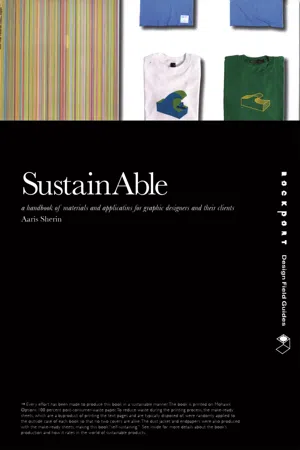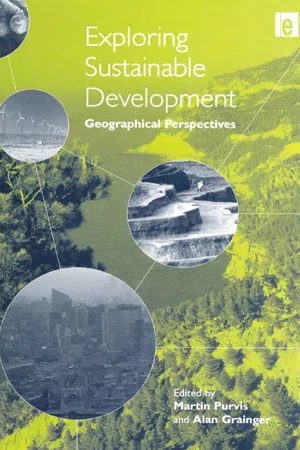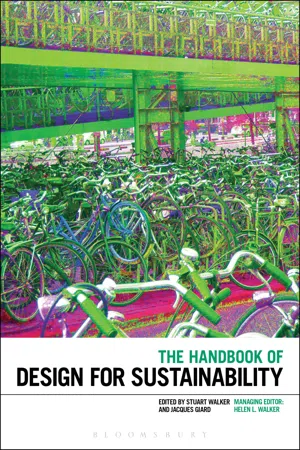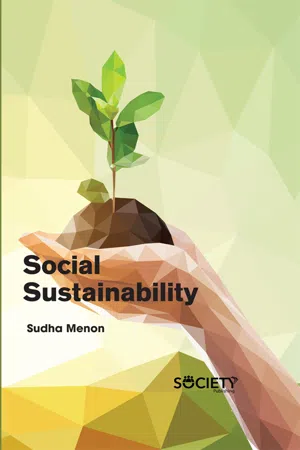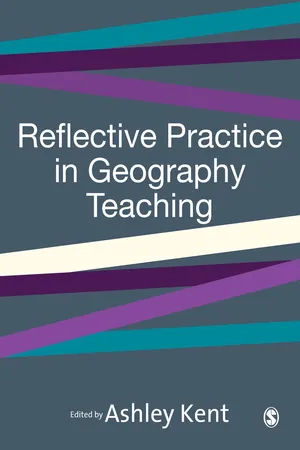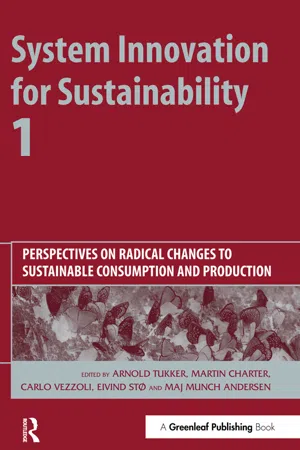Geography
Sustainable Design
Sustainable design refers to the practice of creating products, buildings, and environments that minimize their impact on the natural world and promote ecological balance. It involves considering the long-term environmental, social, and economic consequences of design decisions, and often incorporates principles such as energy efficiency, use of renewable materials, and waste reduction.
Written by Perlego with AI-assistance
Related key terms
1 of 5
10 Key excerpts on "Sustainable Design"
- eBook - PDF
SustainAble
A Handbook of Materials and Applications for Graphic Designers and Their Clients
- Aaris Sherin(Author)
- 2008(Publication Date)
- Rockport Publishers(Publisher)
Methods and Theory PART ONE WHAT IS Sustainable Design ? Sustainability can be de fi ned in many ways, but perhaps the easiest way to describe it is as the balanced use of natural, social, and economic capital for the continued health of the planet and future generations. Designers can enter into the discussion and begin to adopt sustainable practices at a variety of levels depending on their individual situations. Even professionals who have spent decades immersed in this issue agree that we have yet to fi nd the perfect ways of balancing our economic needs with the needs of the planet. Therefore, sustainable practice is more about working toward many small goals than it is about living with absolutes. CHAPTER 1: Overview of Sustainable Design SUSTAINABILITY ENVIRONMENTAL ECONOMIC SOCIAL 12 Sustainable Design As global citizens , we have a duty to ensure that our work practices are sustainable, whatever the industry. In simple terms, it’s about ensuring that the actions of today do not compromise the needs of future generations. ANNA CARLILE – principal and founder of Viola Eco-Graphic Design sus . tain . a . ble, adjective 1. Of, relating to, or designating forms of human economic activity and culture that do not lead to environmental degradation, esp. avoiding the long-term depletion of natural resources. 2. Utilization and development of natural resources in ways which are compatible with the maintenance of these resources, and with the conservation of the environment, for future generations. Definition of Terms Continued debate about the legitimacy of the words “sustainable” and “sustainability” suggests that there is a need to reexamine the de fi nitions and proper usage of these terms. In its 2002 up-date, the Oxford English Dictionary de fi nes “sustainable” in two ways that are applicable in this text. When Brian Mikesell, associate librarian for systems and services at St. - eBook - ePub
Exploring Sustainable Development
Geographical Perspectives
- Martin Purvis, Alan Grainger(Authors)
- 2013(Publication Date)
- Routledge(Publisher)
The chapter begins by comparing geography’s long-standing interest in both society and nature, and the links that unite them, with the new agenda of sustainable development. This is followed by a brief review of the attention given to sustainable development in the geographical literature, and to the themes of place and space in discussions of sustainable development. The chapter then moves on to consider the potential for applying geographical skills in planning for more sustainable development. Arguably more important, however, is a greater geographical contribution to critical reviews of current thinking about sustainable development, both in practice and in theory.A Case for Geography
Sustainable development in disciplinary perspective
The concept of sustainable development is innovative and distinctive in pointing to the need for simultaneous attention to maintaining economic growth, meeting social needs and conserving environmental quality. This broad and challenging agenda requires that the exploration of sustainable development as theory and practice is grounded in a profound understanding of social, economic and environmental systems. It will necessarily draw upon the input and insights of a wide range of academics, and also of many others, including politicians, planners, development workers, business managers, farmers and consumers. The emphasis placed here on thinking geographically should not, therefore, be misinterpreted. What follows is not a claim of perfect knowledge or a bid for intellectual hegemony. Rather, our case is that geography can make a valuable and distinctive contribution to wider debates about sustainable development.Although geography – like sustainable development – is often seen as resisting unambiguous definition, three themes may be taken to constitute its core. The first is the study of relationships between humanity and the environment. The second is the exploration of the distinct and differing characters of particular places. And, thirdly, geography is concerned with the documentation and analysis of the spatial patterning of phenomena across the surface of the Earth. The variety of studies embraced by these themes, and the potential for tension between different approaches, have sometimes been regarded as marks of disciplinary weakness. Taken together, however, the different facets of geographical study have the power to advance our understanding of the world in important and distinctive ways (see Massey, 2001). In part, this reflects geography’s transcendence of the conventional intellectual divide between the social and natural sciences. An important element of geography’s purpose is to explore the ways in which specific environmental contexts influence human society, and the impact of human actions on the form of the landscape, environmental quality and biodiversity. It follows that geography does not define itself as the exclusive study of a single category of phenomena, but as a discipline concerned with connections, associations and distributions. Thinking geographically can, therefore, encourage a breadth of vision and capacity for synthesis that seem particularly appropriate to the study of sustainable development (on the need for this holistic perspective see Belsky, 2002; Liverman, 1999; Redclift, 1998). More than this, however, there are clear echoes in the contemporary agenda of sustainable development of long-standing geographical concerns with documenting and improving the state of the world. - eBook - ePub
- Stuart Walker, Stuart Walker, Jacques Giard, Helen Walker(Authors)
- 2013(Publication Date)
- Bloomsbury Academic(Publisher)
4Developing Theories for Sustainable Design
DENNIS P. DOORDAN
INTRODUCTION
Calculate, conserve, compensate; reduce, reuse, recycle; environment, economy, people: these are some of the now familiar mantras of Sustainable Design. They are the pithy distillations of efforts to rethink the terms of design practice in light of contemporary environmental concerns. The quest for design practices and products that satisfy needs and sustain culture is not new. In his first-century B.C.E. treatise De Architettura, the Roman architect Vitruvius advises architects to select sites for new towns that will ensure the healthfulness of the future city. He wrote, “I cannot too strongly insist upon the need to return to the method of old times” (1914, p. 20). He went on to argue that new towns should be sited near dependable supplies of fresh water and fertile land able to support the needs of the community. In the design of houses, Vitruvius maintained, architects should take into consideration location and climatic factors such as prevailing winds, solar orientation, and seasonal variations. In this, one of the earliest surviving articulations of what I will label the good-sense wisdom tradition in the planning of human settlements, the architect is an astute observer of locale and as knowledgeable about topography and climate as he is about geometry and proportion. Two thousand years later, in Operating Manual for Spaceship Earth, Buckminster Fuller offered a strikingly different description of the skill set required by a designer: “We will now tackle our present world problems with a family of powerful thought tools: topology, geodesics, synergetics, general systems theory, and the computer’s operational bitting - eBook - PDF
- Sudha Menon, University of Kerala, India(Authors)
- 2019(Publication Date)
- Society Publishing(Publisher)
Sustainability: A Global Perspective 2 CONTENTS 2.1. Introduction ...................................................................................... 24 2.2. Economic, Social, And Environmental Sustainability In Development Theory And Urban Planning Practice .................... 28 2.3. The Social Discourse And Sustainability ............................................ 29 2.4. Methods For Achieving Sustainable Design ....................................... 33 2.5. Sustainable Development (SD) .......................................................... 39 2.6. Importance Of Sustainable Development (SD) .................................. 44 References ............................................................................................... 49 Social Sustainability 24 Sustainability is the capability of being maintained at a certain level. Sustainable development (SD) is defined as the development that meets the requirements present without compromising with the requirements of future generations. The chapter deals with the notion of sustainability together with SD in which the current approach of modern generation has also been described. Economic, social, and environmental sustainability in urban planning and development theory has been discussed in brief. The relation between social discourse and sustainability, methods for acquiring sustainability such as life cycle design, humane design, etc. have also been explained. Later on, the three key pillars of SD are provided, followed by the significance of SD. 2.1. INTRODUCTION Sustainability can be best defined as the capacity to endure. The word sustainability is derived from the Latin sustinere (tenere, to hold; sus, up). Dictionaries provide more than 10 meanings for sustain, the main ones being to “maintain,” “support,” or endure, that we are discussing about. If we study ecology, Sustainability defines how biological systems remain diverse and productive over time. - Available until 4 Dec |Learn more
- Raymond N. Yong, Catherine N. Mulligan, Masaharu Fukue(Authors)
- 2014(Publication Date)
- CRC Press(Publisher)
463 13 Sustainable Geoenvironmental Engineering Practice 13.1 Introduction 13.1.1 Undeniable Facts The fact that humans require the various elements of a built environment for survival means that harvesting and exploitation of the natural resources and capital items of the geoenvironment are needed to support their needs. What is needed, in the face of this real-ity, is the implementation of • Development and construction techniques, protocols, and activities in a built envi-ronment that accord with the objectives of protecting and maintaining optimal site functionality • Harvesting, exploitation, and development techniques, procedures, plans, etc., that minimize adverse impacts on the geoenviroment • Geoenvironmental engineering management practices that protect the geoenvi-ronment from deleterious and adverse stressor impacts generated from sources associated with the efforts in support of the needs of humans, i.e., sustainable geoen-vironmental engineering practice In the face of the demands to support the needs of the human population, there are some undeniable facts and concerns that need to be confronted. These include • Continued extraction of nonrenewable natural resources such as metal and min-eral resources together with fossil fuels will not only result in their depletion, but will ultimately lead to their exhaustion • Continued exploitation of renewable natural resources at a pace that does not per-mit them to fully replenish or regenerate themselves will also ultimately lead to their exhaustion • Industrial activities such as farming, manufacturing, production, power genera-tion, etc. - eBook - PDF
- Ashley Kent(Author)
- 2000(Publication Date)
- SAGE Publications Ltd(Publisher)
Work A major concern in sustainable societies is work. This relates to the availability of paid employment, the role of unpaid employment and issues to do with the quality of the work available to people. Geography teaching could provide students with an understanding of the changing nature of work in the contemporary world. This should focus on a range of scales from the local to the global. The focus would be on the various explanations for these changes, and developing students’ knowledge of various theories about the economy. In addition students would learn about the ways in which governments seek to provide work. There needs to be a more wide-ranging discussion of the nature of work in contemporary societies, drawing on debates about the desirability of different types of work and the social relations that are involved in them (McDowell, 1999). In all this study, less emphasis should be placed on description and more on examining the various theories and debates about the world of work. Social divisions Students need to examine the extent to which social divisions are compatible with the achievement of a sustainable society. They need to be introduced to the way in which social divisions occur along lines of race, gender, age and class (Philo, 1995). In geography an important dimension of division is location. While there is a need to understand the empirical bases of these divisions, of equal importance is an understanding of the social processes that work to cause these divisions. These areas might include a study of inequalities in the provision of health and education, as well as the construction of groups such as the ‘underclass’. The focus in this work would be on what might be done to reduce these social divisions (see Hill, 2000). Environment School geography has laid claim to the study of the environment in the school curriculum. - Sushila Sinha(Author)
- 2020(Publication Date)
- Society Publishing(Publisher)
This effort of protection can be done through making the union of all stakeholders such as government policies, organizational, social and others, at all the levels like international, national and regional. Introduction To Sustainability: A Global Perspective 11 1.2.3. Final Considerations There are terms such as sustainable, sustainable and SD which are used at the global level is noteworthy and timely, but because of the embryonic factor of these terms, they still lack an axiomatic concept, they can still generate some criticism and doubts in its theoretical as well as practical application. Considering this context, the analysis of the attributes of those terms was done through bibliographic research, in order to contribute to its axiomatic conceptualization. The results thus obtained show that the term sustainable is responsible for formulating a solution considering the deterioration observed in the interrelationships of the global human environmental system. The process of SD and sustainability supports the concept of sustainable, therefore, it can be considered as an ‘umbrella term.’ This is the reason why, the direction and focus of sustainability and SD should be aligned along with the ultimate intent of being sustainable taking into account the equity of environmental, social and economic aspects. Sustainability is said to be a process that measures either the degree or quality level of the complex human environmental system for evaluating its distance from the sustainable.- eBook - PDF
Product Design for the Environment
A Life Cycle Approach
- Fabio Giudice, Guido La Rosa, Antonino Risitano(Authors)
- 2006(Publication Date)
- CRC Press(Publisher)
Highlighting the strategic role which design may play, sustainable production requires a Design for Sustainability approach, which should be thought of as “a decision-making process that aims at achieving maximum benefits with minimum use of resources, by integrating all economic, social, human, environmental, and ecological concerns” (Ling, 1997). 1.6 Standards and Regulations Oriented toward Environmental Quality of Products With reference to industrial production, diverse motivating factors drive manufacturing companies toward the adoption of policies and instruments aimed at environmental protection (Fiksel, 1996; Bras, 1997): • Introduction of standards for the management of environmental systems, and the promotion of certification of the environmental quality of products • Legislation oriented toward extending the manufacturer’s responsi-bility beyond the commercialization of products, going as far as From Sustainable Development 25 imposing the management of the end-of-life phase with a strong drive toward recovery and recycling • Increasing attention on the part of consumers with regard to envi-ronmental protection In this last section we introduce some of the most significant regulatory initiatives for incorporating environmental considerations into product development. These initiatives intend to reinforce and redirect environmen-tal policies, with the ultimate aim of evoking the primacy of ecological production in companies, integrating environmental requirements into prod-uct standards. 1.6.1 Environmental Standards and Product Certification Perhaps the most effective means of promoting the principles of environmental quality in the context of design intervention is the creation of standards that encourage a preventive approach to environmental problems. Standards have the great advantage of promoting the importance of design in industrial production and product development. - eBook - PDF
System Innovation for Sustainability 1
Perspectives on Radical Changes to Sustainable Consumption and Production
- Arnold Tukker, Martin Charter, Carlo Vezzoli, Eivind Stø, Maj Munch Andersen(Authors)
- 2017(Publication Date)
- Routledge(Publisher)
In this framework the following chapter reviews how the discipline of design for sus-tainability has enlarged its scope and field of action over the past two decades: from material and energy low-impact selection to life-cycle design (or ecodesign) of products, eco-efficient (product-service) system design and design for social equity and cohesion. We describe how this evolution has opened a debate on the role of design itself, a dis-cipline that is already undergoing a redefinition of its (potential) role, as a consequence of other socioeconomic transitions (i.e. service orientation, interconnection, globalisa-tion–localisation [glocalisation]). The argument will then focus on the emerging hypothesis that a design approach seeking to effectively tackle radical innovation and sustainable consumption should operate (and define its real potential and the way to do so) on a system innovation level. In other words, we require ‘design with a strategic approach’, as this extension of the design role (field of action) is described in various design schools. The design research and discussion on this issue is framed within mainstream mar-ket dynamics; nevertheless, particular attention is given to promising economic mod-els, referred to as distributed economies (i.e. locally based and network-linked enterprises and initiatives). Finally, the chapter will discuss present and potential roles for design, and its limita-tions. 8.2 State of the art: understanding the present and potential role of design When discussing the role of design in the transition towards sustainability, particularly in the design and development of sustainable product and service systems, it is useful to introduce certain general considerations about the nature of design itself and about the evolutionary dynamics that have invested it during its relatively brief history. The meaning of the word design changes according to context (Box 8.1). - eBook - PDF
Environmental Engineering
Fundamentals, Sustainability, Design
- James R. Mihelcic, Julie B. Zimmerman(Authors)
- 2021(Publication Date)
- Wiley(Publisher)
Design a future without pollution and waste 4. Create efficient, healthy, resilient cities 5. Foster informed decisions and actions Engineers must develop and implement solutions to these challenges with an understanding of the potential benefits and impacts over the lifetime of the design to advance solutions to sustainability challenges that are in and of themselves sustainable. In this way, the traditions of innovation, creativity, and brilliance that engineers use to find new solutions to any challenge can be applied to designing sustainable solutions—that is, solutions that not only address grand societal chal- lenges but also are in, and of themselves, sustainable by not creating legacy adverse impacts on the environment and society. Mutual bene- fits resulting from this green engineering view of design include a com- petitive and growing economy in the global marketplace, improved quality of life for people, and enhanced protection and restoration of natural systems. 1.3.1 FRAMEWORKS FOR Sustainable Design To support the design of these sustainable solutions, the Principles of Green Engineering (Application 1.10) were developed to provide a framework for thinking in terms of Sustainable Design criteria that, if fol- lowed, can lead to useful advances for a wide range of engineering problems. Green chemistry is a field devoted to the design of chemical products and processes that reduce or eliminate the use and generation of hazard- ous materials (Anastas and Warner, 1998). Green chemistry focuses on addressing hazard through molecular design and the processes used to synthesize those molecules. The fields of green chemistry and green engineering also use the les- sons and processes of nature to inspire design through biomimicry (Benyus, 2002). Biomimicry (from bios, meaning life, and mimesis, mean- ing to imitate) is a design discipline that studies nature’s best ideas and then imitates these designs and processes to solve human problems.
Index pages curate the most relevant extracts from our library of academic textbooks. They’ve been created using an in-house natural language model (NLM), each adding context and meaning to key research topics.
